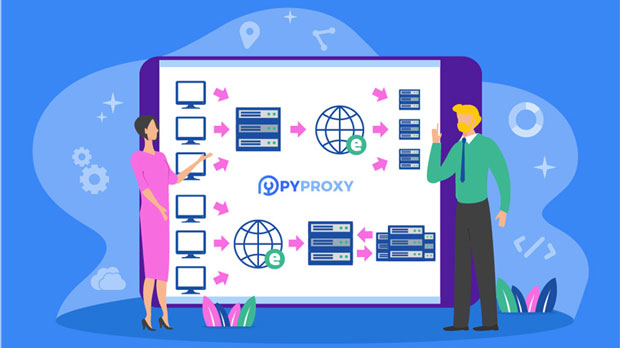When it comes to managing HTTP requests through proxies in a secure HTTPS environment, two prominent tools stand out: PYPROXY and Curl Proxy. Both of these proxy solutions serve as bridges for routing requests between clients and servers, allowing users to mask their IP addresses or manage network traffic. However, there is a significant difference in performance, security, and flexibility between PyProxy and Curl Proxy under HTTPS encrypted transmission. This article aims to provide a deep dive into these tools, comparing their capabilities in terms of speed, resource consumption, ease of use, and how they handle secure HTTPS encryption. Understanding the nuances of these tools will help users make an informed decision based on their network performance requirements and security needs. Introduction to Proxy SolutionsIn an increasingly digital world, ensuring secure and efficient data transmission over the internet is critical. Proxy solutions like PyProxy and Curl Proxy allow users to route requests through an intermediary server, masking the original IP address while enhancing privacy and security. With the implementation of HTTPS encryption, these proxies are designed to support encrypted data traffic, providing both security and anonymity for users. While proxies are often used for web scraping, secure data transfers, or bypassing regional restrictions, their performance under HTTPS encryption can vary significantly. With HTTPS ensuring that data is encrypted end-to-end, the role of proxies in maintaining security and performance becomes increasingly vital. PyProxy and Curl Proxy, both capable of handling such encryption, differ in implementation and efficiency.Understanding PyProxy: Overview and Key FeaturesPyProxy is a Python-based proxy server that is widely used in web scraping, anonymization, and secure data transmission applications. It provides flexibility with the use of Python scripts, making it a powerful tool for developers who need to integrate proxies with other Python-based applications.One of the key features of PyProxy is its integration with Python's extensive libraries and modules, which allows it to handle various protocols, including HTTP and HTTPS, efficiently. PyProxy leverages Python’s capabilities to create custom scripts that can manage proxy configurations dynamically. For HTTPS encrypted transmission, PyProxy utilizes SSL libraries to ensure that data is securely transferred without compromising encryption integrity.However, a major consideration when using PyProxy is its reliance on Python’s event-driven model. While this provides flexibility, it also leads to higher memory consumption, especially in scenarios involving a large number of concurrent connections. As a result, the proxy server can experience a reduction in throughput and increased latency when handling high volumes of encrypted HTTPS requests.Examining Curl Proxy: Features and AdvantagesCurl Proxy, based on the well-known cURL command-line tool, is another widely used proxy solution for encrypted HTTPS transmission. Known for its speed and efficiency, Curl Proxy is often favored by system administrators and users seeking a lightweight and fast proxy solution.Curl Proxy is highly optimized for performance, especially when it comes to handling HTTPS traffic. Its streamlined codebase, coupled with support for multiple proxy protocols, makes it an ideal choice for scenarios requiring rapid handling of encrypted data. Curl is known for its low overhead, meaning it consumes fewer system resources compared to PyProxy, making it more efficient under high traffic conditions.However, the simplicity of Curl Proxy means it lacks the flexibility of Python-based proxies, especially when custom configurations or integrations are required. Curl Proxy is primarily a command-line utility, and while it can be integrated into scripts, it doesn't offer the same level of automation and customizability as PyProxy.Performance Analysis: Speed and Resource ConsumptionWhen comparing PyProxy and Curl Proxy under HTTPS encrypted transmission, the first metric to consider is performance, specifically the speed and resource consumption. In general, Curl Proxy outperforms PyProxy when it comes to raw speed, especially for high-volume connections.Curl Proxy's efficient implementation and lower memory usage allow it to process a larger number of concurrent HTTPS requests with minimal delay. This makes it more suitable for high-performance scenarios where speed is crucial, such as real-time data fetching or large-scale web scraping. Its low memory consumption ensures that it can handle multiple threads without significant degradation in performance.On the other hand, PyProxy, due to its reliance on Python's event-driven architecture and additional libraries, tends to consume more resources. In high-traffic environments, this can result in slower response times, higher latency, and greater CPU usage. While PyProxy’s flexibility allows for more customization, it is not as optimized as Curl Proxy when it comes to raw performance.Security: Handling HTTPS EncryptionBoth PyProxy and Curl Proxy offer robust security features, but their implementation of HTTPS encryption differs slightly. PyProxy uses Python’s SSL libraries, which are frequently updated and offer a high degree of flexibility when handling HTTPS requests. However, the overhead introduced by Python’s interpreter can sometimes affect the security layer’s responsiveness.Curl Proxy, on the other hand, benefits from cURL's long-standing reputation for handling secure connections efficiently. cURL's SSL/TLS implementation is well-optimized, and it is frequently updated to address security vulnerabilities, making it a reliable choice for handling encrypted data streams. Curl Proxy’s security layer is lightweight and fast, contributing to its overall performance.When it comes to HTTPS encrypted transmission, both tools provide the necessary security protocols to protect data in transit. However, Curl Proxy is often seen as more secure in high-volume scenarios due to its performance optimizations, which reduce the chances of security vulnerabilities arising from resource constraints.Ease of Use: Configuration and CustomizationEase of use is another critical factor in choosing between PyProxy and Curl Proxy. PyProxy, being Python-based, provides a higher degree of customization and flexibility. Developers can easily modify the proxy server’s behavior by writing scripts, integrating with other tools, or adding new features as needed. This makes PyProxy ideal for use cases that require custom logic or automation, such as web scraping with complex requirements.However, this flexibility comes at a cost: PyProxy may require more technical knowledge and effort to set up compared to Curl Proxy, especially for users unfamiliar with Python programming.Curl Proxy, while simpler to configure and use, offers less flexibility. Its primary strength lies in its speed and performance, but this comes with the trade-off of limited customization. Curl Proxy is well-suited for straightforward proxy use cases where customization is not a primary concern.Conclusion: Which Proxy Solution is Right for You?Both PyProxy and Curl Proxy have their strengths and weaknesses, making them suitable for different use cases under HTTPS encrypted transmission. PyProxy offers a high degree of customization and flexibility, making it ideal for developers who need more control over proxy configurations. However, it comes with higher resource consumption and slower performance under heavy loads.Curl Proxy, on the other hand, excels in raw performance and resource efficiency, making it the better choice for high-speed, high-volume applications. While it offers fewer customization options, it is easier to configure and maintain, making it more suitable for straightforward use cases.Ultimately, the choice between PyProxy and Curl Proxy will depend on the specific needs of your project. If you require high performance and low resource usage for secure HTTPS traffic, Curl Proxy is likely the better option. If flexibility and customizability are more important, PyProxy may be the better fit for your needs.
Sep 08, 2025



































































